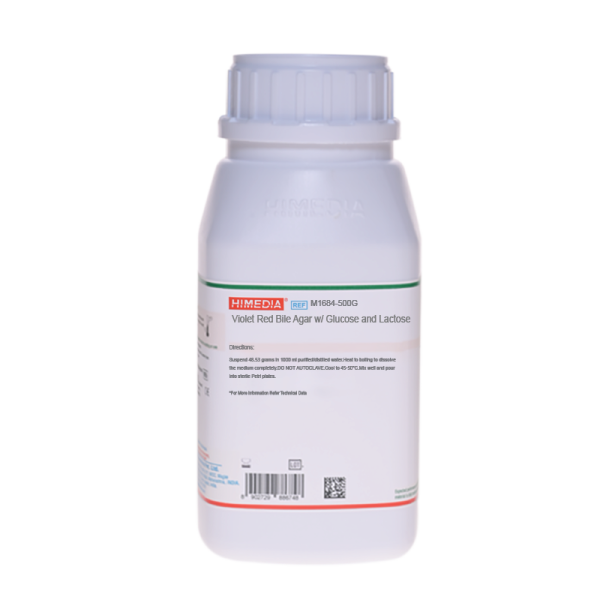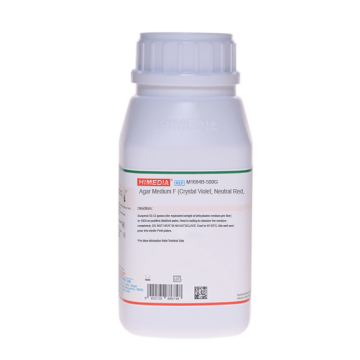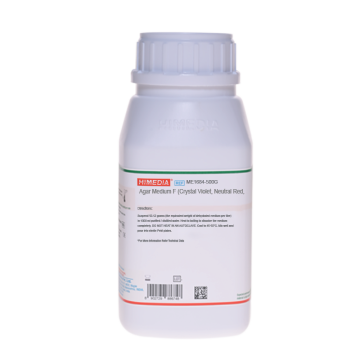 Your enquiry has been submitted
Your enquiry has been submitted
Violet Red Bile Agar w/ Glucose and Lactose
Intended use
For selective isolation and enumeration of coliaerogenes bacteria in water, milk, other dairy food products and clinical samples.
Composition**
| Ingredients | g/ L |
|---|---|
| Peptone | 7.000 |
| Yeast extract | 3.000 |
| Sodium chloride | 5.000 |
| Bile salts mixture | 1.500 |
| Glucose | 10.000 |
| Lactose | 10.000 |
| Neutral red | 0.030 |
| Crystal violet | 0.002 |
| Agar | 12.000 |
Final pH ( at 25°C) 7.4±0.2
**Formula adjusted, standardized to suit performance parameters
Directions
Suspend 48.53 grams in 1000 ml purified/ distilled water. Heat to boiling to dissolve the medium completely. DO NOT AUTOCLAVE. Cool to 45-50°C. Mix well and pour into sterile Petri plates.
Principle And Interpretation
Violet Red Bile Agar w/ Glucose and Lactose is a selective medium recommended for detection of Enterobacteriaceae species. Mossel et al (1-4) added glucose to the medium and observed an improved detection of coliforms. Incubation can be carried out at different temperatures and incubation time depending upon the group of Enterobacteriaceae to be recovered (3).
Peptone and yeast extract provide nitrogenous and carbonaceous compounds, long chain amino acids, vitamins and other nutrients essential for bacterial metabolism. This media is selective due to presence of the inhibitors; bile salts mixture and crystal violet. Crystal violet inhibits gram-positive organisms especially staphylococci. Neutral red indicator helps to detect lactose and glucose fermentation. Lactose and glucose fermenting strains grow as red or pink coloured colonies and may be surrounded by a zone of acid precipitated bile. Sodium chloride maintains the osmotic equilibrium in the medium. The red colour is due to absorption of neutral red and a subsequent colour change of the dye when the pH of medium falls below 6.8.
Type of specimen
Clinical samples : faeces, Food and dairy samples; Water samples.
Specimen Collection and Handling
For clinical samples follow appropriate techniques for handling specimens as per established guidelines (5,6).
For food and dairy samples, follow appropriate techniques for sample collection and processing as per guidelines (7,8,9).
For water samples, follow appropriate techniques for sample collection, processing as per guidelines and local standards.(10)
After use, contaminated materials must be sterilized by autoclaving before discarding.
Warning and Precautions
In Vitro diagnostic Use. For professional use only. Read the label before opening the container. Wear protective gloves/protective clothing/eye protection/ face protection. Follow good microbiological lab practices while handling specimens and culture. Standard precautions as per established guidelines should be followed while handling clinical specimens. Safety guidelines may be referred in individual safety data sheets.
Limitations
- Further biochemical tests must be carried out for confirmation.
Performance and Evaluation
Performance of the medium is expected when used as per the direction on the label within the expiry period when stored at recommended temperature.
Quality Control
Appearance Light yellow to pink homogeneous free flowing powder
Gelling Firm, comparable with 1.2% Agar gel.
Colour and Clarity of prepared medium Reddish purple coloured clear to slightly opalescent gel forms in Petri plates.
Reaction Reaction of 4.85%w/v aqueous solution at 25ºC. pH : 7.4±0.2
pH 7.20-7.60
Cultural Response Cultural characteristics observed after an incubation at 35-37°C for 18-24 hours .
| Organism | Inoculum (CFU) | Growth | Recovery | Colour of colony |
|---|---|---|---|---|
| # Klebsiella aerogenes ATCC 13048 (00175*) | 50-100 | good-luxuriant | >=50% | pink-red |
| Escherichia coli ATCC 25922 (00013*) | 50-100 | good-luxuriant | >=50% | pink-red with bile precipitate |
| Salmonella Enteritidis ATCC 13076 (00030*) | 50-100 | good-luxuriant | >=50% | light pink |
| Staphylococcus aureus subsp.aureus ATCC 25923 (00034*) | >=104 | inhibited | 0% | |
| Escherichia coli ATCC 8739 (00012*) | 50-100 | good-luxuriant | >=50% | pink-red with bile precipitate |
| Staphylococcus aureus subsp.aureus ATCC 6538 (00032*) | >=104 | inhibited | 0% |
Key : (*)Corresponding WDCM numbers, (#) Formerly known as Enterobacter aerogenes
Storage and Shelf Life
Store between 10-30°C in a tightly closed container and the prepared medium at 20-30°C. Use before expiry date on the label. On opening, product should be properly stored dry, after tightly capping the bottle in order to prevent lump formation due to the hygroscopic nature of the product. Improper storage of the product may lead to lump formation. Store in dry ventilated area protected from extremes of temperature and sources of ignition Seal the container tightly after use. Product performance is best if used within stated expiry period.
Disposal
User must ensure safe disposal by autoclaving and/or incineration of used or unusable preparations of this product. Follow established laboratory procedures in disposing of infectious materials and material that comes into contact with sample must be decontaminated and disposed of in accordance with current laboratory techniques (5,6).
References
- Mossel D.A.A., Mengerink W.H.J. & Scholts H.H., 1962, J. Bacteriol, 84 : 381.
- Mossel D.A.A. et al, 1978, Lab. practice, 27 No. 12 : 1049
- Mossel D.A.A.et al, 1979, Food Protect., 42 : 470.
- Mossel D.A.A. et al, 1986, J. Appl. Bact., 60 : 289
- Isenberg, H.D. Clinical Microbiology Procedures Handbook 2nd Edition.
- Jorgensen, J.H., Pfaller, M.A., Carroll, K.C., Funke, G., Landry, M.L., Richter, S.S and Warnock., D.W. (2015) Manual of Clinical Microbiology, 11th Edition. Vol. 1.
- American Public Health Association, Standard Methods for the Examination of Dairy Products, 1978, 14th Ed., Washington D.C.
- Salfinger Y., and Tortorello M.L. , 2015, Compendium of Methods for the Microbiological Examination of Foods, 5th Ed., American Public Health Association, Washington, D.C.
- Wehr H. M. and Frank J. H., 2004, Standard Methods for the Microbiological Examination of Dairy Products, 17th Ed., APHA Inc., Washington, D.C.
- Lipps WC, Braun-Howland EB, Baxter TE,eds. Standard methods for the Examination of Water and Wastewater, 24th ed. Washington DC:APHA Press; 2023.
| Product Name | Violet Red Bile Agar w/ Glucose and Lactose |
|---|---|
| SKU | M1684 |
| Product Type | Regular |
| Physical Form | Powder |
| Origin | Animal |
| Packaging type | HDPE |
| References | 1. American Public Health Association, Standard Methods for the Examination of Dairy Products, 1978, 14th Ed., Washington D.C. |
| Customized Product Available | No |









